Gathering Of Tribes is a nonprofit organization founded to support Native American and First Nations Latter-day Saints in the US and Canada by working collaboratively with the Church to nurture faith in Christ, support family history work, and celebrate cultural identity.
The impetus of the LDS Women Project was to refute the idea that being a Latter-day Saint woman had to look one certain way, and to demonstrate that our diversity is our strength. Gathering Tribes exemplifies this. Could each of you tell us about yourself and how you got involved in Gathering of Tribes?
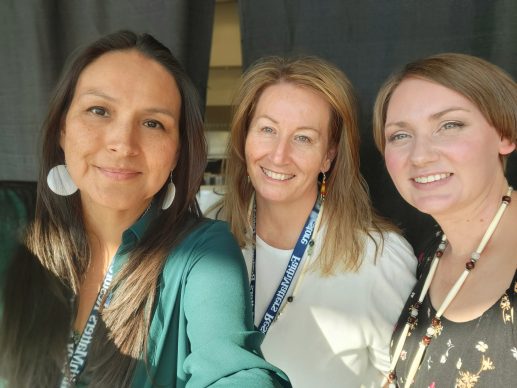
Cindy Quinney, Shane Manning, Amber Irwin from Gathering of Tribes
CINDY QUINNEY: I’m from the Cree tribe in Saskatchewan, Canada. I currently live in Calgary, Alberta, and I am the Executive Director of Gathering Of Tribes. This work started in 2021 to gather Indigenous people who are members of the Church, so I could see more people that look like myself and build connections. A prompting of the Spirit about gathering together started us to move forward with this project.
SHANE MANNING: I live in Gilbert, Arizona, and I’m the mom of a multicultural, multiracial family; we’re an adoptive and foster family. My people are in Oklahoma, but we’ve been in Arizona for a couple of generations. My dad’s side is Muscogee Creek, and my mom’s side is Mormon pioneers. My husband and I have adopted and fostered – we have seven kids; our oldest and youngest two are Black, we have two Lakota, and two that are white.
As my oldest daughter started Young Women, she pointed out that she was the only person of color in this circle. We had been aware of that, but it became important to us to find more people who looked like her, as Cindy just said, so she felt included and that she belonged. I looked into the Genesis group. I started graduate school a couple of years ago to study how a non-Black family helps instill Black identity in adopted children. As I went through my classes, I also started looking at reconnecting with my Indigenous identity and thinking about my Lakota kids in the same way.
When I heard about the first Indigenous gathering in Calgary, I told my husband, “I have to go. I don’t know what this is. I don’t know why it’s happening, but I have to go.” When I got there, I spoke with Cindy about what she was doing and her motivation and the spirit behind it, and I wanted to be a part of this. So here we are, a few years later with a nonprofit and all kinds of stuff going on. I am Director of Operations.
AMBER IRWIN: I am the only non-Indigenous team member, so I have no tribe to claim. I’m the creative director. I’ve been a creative for over twenty years. My roots are in the video game industry – I worked as a 3D artist, and later became a marketing director and creative director for small businesses and nonprofits. When the 2020 pandemic hit, I had just learned sewing and I had the technical skills to build a website, so I organized roughly 2000 volunteers to make fabric masks for the Navajo Nation since they were hit so hard. We made over 100,000 masks in ninety days, and expanded to different tribes that also needed them. Right after that, I became a marketing director for a nonprofit organization that provides scholarships to Native American students seeking higher education.
I am the mom of five boys and a wife. I’m also going back to school. I’m currently getting a second bachelor’s degree and going into art therapy, and that will eventually be followed by law school. To what purpose, I don’t know, but I feel inclined to do that.
Can you explain about Gathering of Tribes for people who aren’t familiar?
CINDY: The purpose of Gathering of Tribes is to help meet the needs of the Indigenous members of the Church, to bring them closer to Christ through our cultural identity and our connection to the Savior.
I was adopted when I was younger. I lived with my Indigenous family until age ten, then I lived with a foster family who was LDS. At church, there were no Indigenous members for me to connect with, so I stopped going for a number of years. When I came back to church and got my temple recommend, I went to the temple and saw an Indigenous member. I was super excited and immediately said hello, because I was so happy to see him. I’m sure he thought it was really weird. I was invited to church the next day out in Morley, a First Nations settlement on the Indian reserve in southern Alberta. It was the first time I’d been in sacrament meeting with all Indigenous members, and I don’t think I’d felt the Spirit that strong in a long time. I felt that we needed to be together.
I made the effort to go out there a few other times, and the Spirit prompted me to have a gathering-like conference. I didn’t really listen to the Spirit, I thought that would be great for someone else to do. But eventually, I did get on my knees and prayed and prayed, “Well, this is what you want me to do. I’ll do it, but I need you to send the right people to help me because I can’t do this on my own.” The Lord blessed me with some amazing sisters, including these two women. I’ve worked with many others, from the first committee to the most recent committee, and I’m blown away by the members of the Church when they feel the spirit of something that’s important to Heavenly Father. He’s trying to strengthen all of us and let us all know that we’re loved, no matter what we look like.
The dual meaning of the name Gathering Of Tribes is not lost on me. There’s the gathering of Indigenous tribes, building community within our larger community. And as Latter-day Saints, part of our call and responsibility to the world is to gather the twelve tribes of Israel.
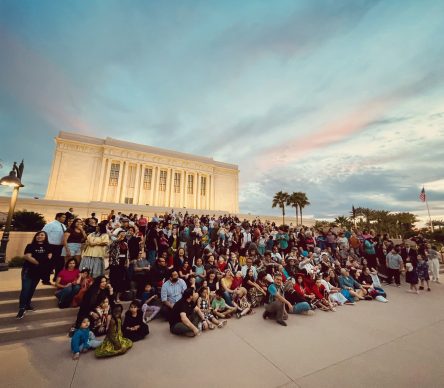
Gathering of Tribes
CINDY: I give credit for the name to a friend from Morley. She first said, “gathering nations,” then she said, “gathering tribes” and it stuck.
AMBER: When everyone was on lockdown, I started listening to podcasts and randomly came across Tribe of Testimonies by Andrea Hales. She interviews Native American and First Nations peoples about their testimonies and living in the Church of Jesus Christ of Latter-day Saints. Cindy was a guest, talking about a grassroots movement of gathering. I didn’t know how to help from so far away, but I can make a website. I have graphic skills. I contacted Andrea Hales and asked for Cindy’s email, and said, “If you need me, let me know.” It’s been five years.
Can you talk about that first gathering? What types of things happened there?
CINDY: I had a dream that we were at the temple in regalia, and all our ancestors were there on horses. I felt it was important that we gather at the temple and start preparing for the Second Coming.
SHANE: We gathered in Calgary at the temple, and there’s a ward building that shares the parking lot. Cindy got a photographer and a drone operator, and everyone wore regalia for the picture in front of the temple – all these Indigenous people representing their histories and their ancestors with their traditional clothing. The temple was closed for annual cleaning so we had the grounds to ourselves. We had a wonderful visit with all the people, there was some spontaneous singing, and we walked around the temple. In traditional culture, you honor the four directions so we walked all four of the directions, then gathered together at the front of the temple for the group photo. It was a beautiful moment and representation of what we’re trying to do.
That evening in the church building, we had dinner and a cultural dance and celebration. The next day, we had conference sessions and speakers. There were a lot of people from Calgary, and at least three different groups of people from Arizona.
In doing this work, what have you learned about the nature of our Heavenly Parents?
CINDY: When I think about my connection to Heavenly Father and Heavenly Mother, I just love people so much. I look beyond what’s going on in their life and try to see them and the potential they have, as Heavenly Father does. Sometimes it’s hard, but I don’t want to give up on someone. In this gathering and all the different committees, we have different personalities, and we’re Indigenous, and we can be fiery. We have our opinions, but try to be leaders in a loving way with everyone we meet, and learn from the experiences.
SHANE: A majority of the Indigenous community in North America has been touched by foster care and adoption. There’s so much family loss in these communities because of governmental policies for so many generations. Amber has an adopted son, and she’s in the works with some other things. We are currently fostering and have adopted children, and Cindy herself was a foster child. When I think about our Heavenly Parents, how They want us to be connected to Them, I visualize and understand the temple sealing in a different way than a lot of people. We’ve taken our adopted children to the temple to be sealed, and when we do that ceremony, I feel that I’m not just being sealed to that child, but also to their biological family. I feel an obligation and a connection to them moving forward.
People often think of the sealing as a chain going back generations, but I envision it as a web because I’m connected to my children and their biological families for generations, forward and backward, and everywhere, which is also the seven generations. The seven generations is an Indigenous teaching that connects you backward and forward for that many generations. When I think of our Heavenly Parents, I think of that. They want us to be sealed and connected to Them, and to recognize that we are all sealed into the family of God. It’s not just your biological family line, we are all sealed together. We are all responsible to and for each other, and we will answer for that when we return to our Heavenly Parents.
The three of you have come together focused on gathering. I’m wondering if there’s something that’s inherently matriarchal in the desire to gather and to demonstrate how to bring people together. That’s not to say that men don’t gather. What do you think?
AMBER: We hosted a devotional in October 2024 called Sacred Sisters, and my talk was called “A Mother’s Prayer.” When we look to the scriptures, whenever the Lord speaks about gathering, He uses a feminine form – a hen will gather her chicks, she will not forget the suckling child. It’s all feminine. We’re given a gift to be the kin-keepers. I think there’s no mistake that the spiritual prompting for this organization, Gathering Of Tribes, was given to women. Historically, Indigenous communities are matriarchal. The bloodline goes through the women. That’s where they recognize us, because that is where we come from. Every story starts with a woman, so I do think there is a natural gift given to women to gather.
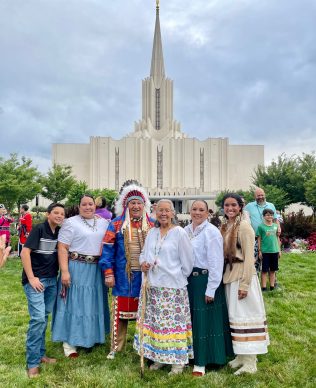
Gathering of Tribes
CINDY: As women, we’re creators. That’s the blessing we have. We can create peace within a family. We can create community, trying to show love. We have a soft side, and there’s strength in being like that because it’s Christlike love. Our culture is matriarchal; women make decisions in a lot of the tribes. Even though it probably doesn’t seem like it, men will turn to women – their wives, their mothers, their sisters – for opinions because we have a different perspective. We all have access to heavenly communication. We can get inspired. We couldn’t do this work if we didn’t open that portal and talk to Heavenly Father for guidance. Nothing stops us from doing that.
SHANE: We’ve been in contact with different church leaders, mostly at the area level. Cindy wanted to make sure that we have priesthood approval and guidance. We were looking at bringing in a priesthood holder for the leadership team – praying about who it could be and what kind of role they would have. We had a meeting with a member of my North America Southwest area presidency, and brought that up with him. I was really grateful for him saying, “You don’t need to bring a priesthood holder into your organization, unless you feel that you need to do that. Don’t feel like you need to seek that out. If you receive inspiration, go ahead and do it. You have all the authority and all the power that you need right now.” That was really wonderful and reassuring to hear from an office holder in the priesthood.
On your website, you talk about gathering, uplifting, and service. How does that guide the work that you’re doing?
AMBER: Our mission is to strengthen and minister to Indigenous Latter-day Saints. And I just want to make sure to note that although we want to serve as a platform and an amplifier for Indigenous voices in the church, all are welcome to participate. We don’t want anyone to feel excluded. This is a time to be together. Our core values are to make sure that we’re aligning with the church values, which is making sure that we’re encouraging, nurturing your faith in Jesus Christ, and uniting families on both sides of the veil. I think that’s what we didn’t talk about – it’s not necessarily just our side, it’s also the other side, making sure we’re connected with our ancestors. We want to make sure that we’re caring for those in need and celebrating cultural identity as it relates to the gospel.
CINDY: We had a fireside in Cardston, trying to encourage Indigenous members to build a relationship with their local leadership and to use their skills to gather people in their area to help strengthen them. The gathering of tribes means two things – the gathering of Indigenous and the gathering of the tribes of Israel. Like Amber was saying, everyone is invited. You don’t have to be Indigenous. The most important thing for us is that everyone feels loved without judgment. They’re welcome to come, be a part of it, and feel the Savior’s love and the love of a community that’s there to support them.
The one thing I can say that’s been a blessing of all the gatherings is the feeling there. It’s beautiful, it’s fun, it’s happy, it’s joyous. We always like to meet at the temple first. That’s how we start the gatherings. We encourage people to bring family names, to focus also on gathering on the other side of the veil, which is what we’re trying to do and promote amongst our people.
AMBER: My greatest desire for this project is that more people are inspired to host gatherings in their own areas. We can’t do it all but we can show you how we’ve done it. There’s such beauty when Latter-day Saints of all different backgrounds come together and share not only their faith, but share their cultural identity as it relates to the gospel of Jesus Christ. Heavenly Father speaks to His children all over the world, and because of that, there are so many incredibly vibrant and rich cultural practices and traditions that all testify of Him and His light. There is so much we can learn about the character of Christ and our Heavenly Parents if we create safe spaces to share ancestral teachings and celebrate our diversity. I think if we do this and embrace the good that we each have to offer, we’ll find the unity that we keep talking about and we’re continually striving for.
I do think that there’s a power that comes when we share these good things, and it gives us the opportunity to learn more of Christ and of each other. The world can use more understanding right now, if we could come together as siblings that share the same Heavenly Parents. To me, these are a type of family reunion, and we should be having a lot more family reunions.
I’m reminded of Rabbi Jonathan Sacks’ The Dignity of Difference – the thesis being that we actually need differences to draw closer to God.
AMBER: That’s how you compose music, right? You have to have all the notes.
SHANE: I had a conversation with a woman at the Utah gathering in 2023. She’s white and her husband is Black and Indigenous, so their children have a beautiful mix. They participate in the Genesis meetings, and they also came to our gathering. She said, “I don’t know if this is weird for me to say as a white woman, but I find so much value in seeing the ways that different people worship and the way that they talk about God and Jesus Christ. It expands my understanding of who They are when I see the different relationships that people from different cultural backgrounds have.”
That’s part of what we’re doing – opening a willingness to understand Jesus Christ through a different cultural perspective, and understand that the white Mormon way that we do things in the 2020s is not what we were doing in the 1830s and 1840s. There’s a culture in the church that has built up and people think that it’s the gospel. We want to open that up a little. Let’s change. Let’s bring in different perspectives and experiences and see if your relationship with your Savior and with your Heavenly Parents can change and develop, and grow as you look at Them through a different lens.
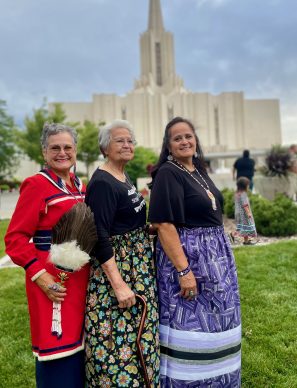
Gathering of Tribes
CINDY: I have a daughter in her 20s who is not really active in the church, but she has testimony. She helped plan the gathering because she’s invested in this and wanted to see what was going to happen. My daughter is half Native and half Black, and has felt like Shane’s daughter – she doesn’t see anyone else like herself in church. She came to a planning meeting with church leaders, and shared her thoughts about the importance of feeling part of a community. Because she bore testimony that it is important to feel welcomed and connected with others, she was able to soften the hearts of the leaders so that we could move forward with the gathering. I’m grateful for diversity because it brings beauty. The reason we’re all made different is to see how Christlike we would be.
What does it mean to you to be a Latter-day Saint woman in 2025? When you think about taking that on as one of your identities, what does that look like?
AMBER: We live in such a unique time, unlike any other generation before us, where we have technology and these communities that we can gather. Cindy’s in Canada, Shane’s in Arizona, I’m in Ohio. We have social media and all these other ways to connect and to be kin-keepers, to gather others. The restoration is unfolding right before our eyes and moving at such a rapid pace – we’ve been challenged to seek a deeper understanding of our covenants in the priesthood; Heavenly Mother is being openly discussed and cherished; women scholars have dedicated themselves to learning Hebrew and sharing incredible new insights from the scriptures, and providing insights into the history of the church. I know that we each have an individual path to walk, and each of our stories and our work is so divinely and carefully crafted for us. Being a Latter-day Saint woman in 2025 is filled with opportunity – to learn, to teach, to influence, to share, to serve, to gather, to testify, to love and to be loved, and most importantly, to strive to fulfill our greatest potential. It’s an open adventure. It’s ready and waiting.
SHANE: My identity as a Latter-day Saint woman, in this time of chaos and fear, provides hope and respite. There’s so much fear in the world of scary things that are happening, but also of each other – of our brothers and sisters. An identity in the Church and in the Savior helps us to put that fear away and turn to love.
We recently had a hard time in our neighborhood. It was partly in our ward and generally in the neighborhood. It kind of resolved and there was nothing else to do about it, but there were some hard and hurt feelings at the end of it. I got my kids together, we went to Trader Joe’s to get little bundles of flowers and some packages of candy, and we went to four or five different houses of the people who were on the receiving end of the hard feelings. We left the flowers and notes that said, “We just want you to know that we love you.” I talked to my kids about it – people are afraid, and when they’re afraid, they get mean. We need to put fear and anger aside and reach out in love. That’s what the gospel and the Savior are giving to me right now, and what I’m hoping to teach to my kids.
CINDY: It’s okay that I have imperfections because I know that Heavenly Father loves me the way I am. He makes up the difference. There are so many ways in which I lack. These two women that He’s brought into my life – they’re fantastic, so talented, so smart. They know how to do things that I don’t, and they know how to bring things together. If I do something, I always say, “Can you edit this or look at this?” I like asking for their opinion. I’m learning to be a better team player.
Having the identity of a child of God helps me realize that I’m doing my best, and I can move forward, trusting in Him. Even when I make a mistake, I know that I can go to my Heavenly Father in prayer and ask for help to keep going. There are so many things as women that we can learn in the gospel and the temple about accessing the power of heaven, and what blessings and power we have with us when we go out into the world to keep holding all the pieces together. I’m grateful to be a member of the Church.
Is there anything else you want to add before we close?
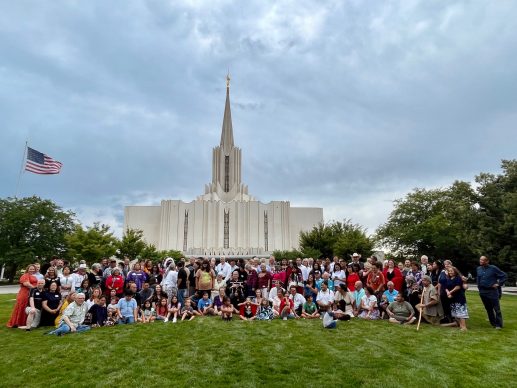
Gathering of Tribes
CINDY: We want to emphasize again that everyone is welcome, no matter where your testimony is. If you believe in God just a little bit, or you have a deep, long history with the Church, you’re welcome to come and experience Christlike love and family and connection and diversity. Anyone who feels inspired to be a part of this or wants to help, please reach out. We know this is divinely inspired work, and Heavenly Father has more people whom He would like to strengthen with regard to serving our brothers and sisters.
AMBER: The organization is in its infancy, and we need all the help that we can get. My biggest struggle right now is trying to take care of five little boys and do this full-time job at the same time. I don’t think enough people know about us or what we’re doing. Sharing our website and email with new friends, listening to the podcast and leaving a good review, sharing your favorite episode on social media – things like that would be so helpful to us, so people know who we are, and if they feel inspired, they can come.
SHANE: I want to bring up our education goal. There’s a lack of knowledge among the mainstream community. There’s a lot of pain. There’s a lot to heal and reconnect in these communities, and we need to love both ways. We need to forgive on both sides. One of our goals is to educate people and leaders in the Church about the history of Indigenous people in North America. There are a lot of people with Native ancestry that their leaders don’t recognize. That’s another concern – leaders will hear about our events, but think they don’t have anyone Indigenous in their ward so they don’t need to announce it. That’s not always the case. If my bishop didn’t know the work I’m doing, he probably wouldn’t realize my background or connections. We want people to realize that you don’t know who’s all around you. We also want people to be aware of the history of the relationship between the Church and Native people, and look to the future. We want to come together and heal, to be one in the Zion community that the Lord needs to be able to return.
CINDY: We need to build a bridge so we can do the Lord’s work. When you study the Book of Mormon, maybe try to see it through Indigenous eyes, with curiosity about the role of the Indigenous, and try to fully understand what we’ve been through. Shane talked about healing and talking, and communicating – that’s what will help us move forward with love and forgiveness. There’s so much more work to do before the Second Coming, and we have to do it together. We’re not doing it just as Indigenous people and non-Indigenous – we have to work together as one, as a family, to help those who are struggling. That’s really important, that we are one.
AT A GLANCE
Name: Cindy Quinney
Age: 48
Location: Calgary, Alberta Canada
Marital History: Single
Children: One
Convert to the Church? If so, date: Baptized 1987
Education: Trade School
Occupation: Executive Director of the Gathering of Tribes
Languages Spoken at Home Love
Favorite Hymn: I know that my Redeemer Lives
Name: Shane Manning
Age: 47
Location: Gilbert, Arizona
Marital History: Married
Children: Yes, foster and adopted
Convert to the Church? If so, date: Raised in the Church
Education: BA English; MA American Studies
Occupation: Nonprofit founder/administrator; Native community educational outreach at university
Languages Spoken at Home: English
Favorite Hymn: Battle Hymn of the Republic
Name: Amber Irwin
Age: 40
Location: Ohio
Marital History: Married
Children: 5
Convert to the Church? If so, date: Born and raised in the church
Education: Bachelor’s degree
Occupation: Stay-at-home Parent
Languages Spoken at Home: English, ASL, Spanish
Favorite Hymn: Nearer My God to Thee
Gathering of Tribes social media: @ldsgatheringoftribes
Gathering of Tribes website: https://www.gatheringoftribes.org/
At A Glance
Produced by Elizabeth Ostler
